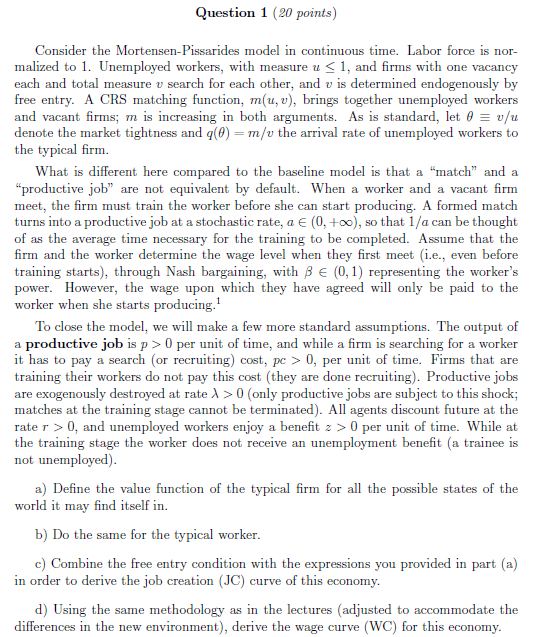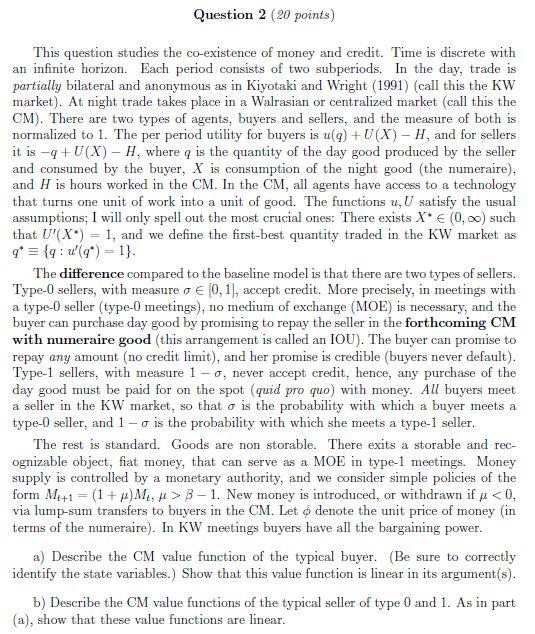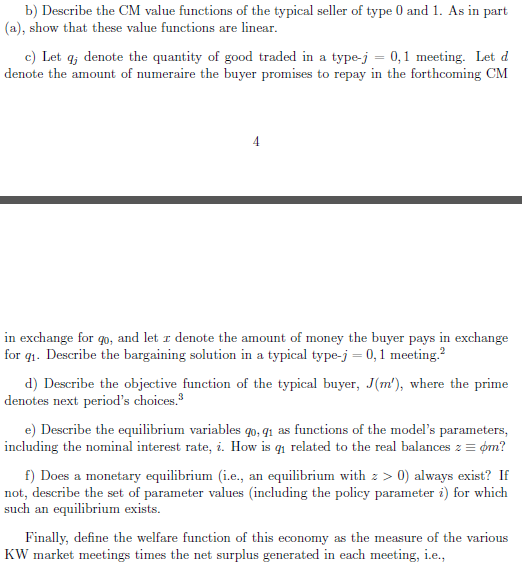



???
Question 1 {EH points] Consider the MortensenPissarides model in continuous time. Labor force is nor- maliaed to l. Unemployed workers, with measure 1!. 5 l, and rms with one vacancy each and total measure tl' search for each other1 and u is determined endogenously by free entry. A CH5 matching function1 mEu,o}, brings together unemployed workers and vacant rms; In is increasing in both arguments. As is standard, let 9 E ofu. denote the market tightness and 1113] = info the arrival rate of unemployed workers to the typical rm. What is diEerent here compared to the baseline model is that a "'match'1 and a \"productive job" are not equivalent by default. When a worker and a vacant rm meet, the rm must train the worker before she can start producing. A. formed match turns into a productive job at a stochastic rate, a. E [I], +co}, so that lfo. can be thought of as the average time necessary for the training to be completed. Assume that the rm and the worker determine the wage level when they rst meet l|:i.e., even before training starts}, through Nash bargaining, with ,6 IE {[1,1] representing the worker's power. However, the wage upon which they have agreed will only be paid to the worker when she starts producing.1 To close the model1 we will make a few more standard assumptions. The output of a productive job is p :2:- [l per unit of time, and while a rm is searching for a worker it has to pay a search [or recmiting] cost, pc 3: U, per unit of time. Firms that are training their workers do not pay this cost [they are done recruiting}. Productive jobs are esogenously destroyed at rate J. 2: I] {only productive jobs are subject to this shock; matches at the training stage cannot be terminated]. All agents discount future at the rate r :b- D, and unemployed workers enjoy a benet .2 it: I] per unit of time. 1|If'ml'hile at the training stage the worker does not receive an unemployment benet [a trainee is not unemployed]. a} Dene the value function of the typical rm for all the possible states of the world it may nd itself in. b} Do the same for the typical worker. c] Combine the free entry condition with the expressions you provided in part {a} in order to derive the job creation [JG] curve of this economy. d} Using the same methodology as in the lectures {adjusted to accommodate the differences in the new environment}, derive the wage curve [WC] for this economy. e] Provide a restriction on parameter values such that a steady state equilibrium pair {191 H] esists. Is it unique? {No need for a lengthy discussion.) f] What is the effect of a decrease in a. on the equilibrium is and 3? Explain analytically and intuitively {but shortly}. 3;} Describe the Eeveridge curve {EC} of this economy by looking at the Flows oi: 1workers in and out of the various states. What effect will the decrease in s {discussed in the previous part]I have on equilibrium unemployment? Question 2 {EH points] This question studies the co-esistence of money and credit. Time is discrete with an innite horizon. Each period consists of two subperiods. In the day, trade is partially bilateral and anonymous as in Kiyotalci and Ii'w'right [1991} {call this the KW market}. At night trade takes place in a Walrasian or centralized market {call this the CM}. There are two types of agents1 buyers and sellers, and the measure of both is nomialiaed to l. The per period utility for buyers is uq} + UEX] H, and for sellers it is q + UEX] H, where g is the quantity of the day good produced by the seller and consumed by the buyer, X is consumption of the night good [the numeraire], and H is hours worked in the CM. In the CM, all agents have access to a technology that turns one unit of work into a unit of good. The functions in, U satisfy the usual assumptions; I will only spell out the most crucial ones: There exists X' E [I], co] such that U"{X"] = l, and we dene the rst-best quantity traded in the KW market as q" E {g : u'{q'] = I}. The difference compared to the baseline model is that there are two types of sellers. Type-[ll sellers, with measure or E [I], I], accept credit. More precisely, in meetings with a type-El seller {type-I] meetings], no medium of exchange {MOE} is necessary, and the buyer can purchase day good by promising to repay the seller in the forthcoming CM with numeraire good {this arrangement is called an ICU}. The buyer can promise to repay any amount [no credit limit]1 and her promise is credible {buyers never default]. Typel sellers, with measure 1 or, never accept credit, hence, any purchase of the day good must be paid for on the spot [quid pro gun] with money. AH buyers meet a seller in the KW market, so that or is the probability with which a buyer meets a type-l] seller, and l r: is the probability with which she meets a typel seller. The rest is standard. Goods are non storable. There eadts a storable and rec ognizable object, at money, that can serve as a MDE in typel meetings. Money supply is controlled by a monetary authority, and we consider simple policies of the form MM] = [l + p}M, a :5 ,3 1. New money is introduced, or withdrawn if}; <: via lump-sum transfers to buyers in the um. let denote unit price of money terms nurneraire kw meetings have all bargaining power. a describe cm value function typical buyer. sure correctly identify state variables. show that this is linear its argument b functions seller type d and as part these are linear. e :1 quantity good traded typej="[1,]" meeting. amount numeraire buyer promises repay forthcoming exchange for q>














